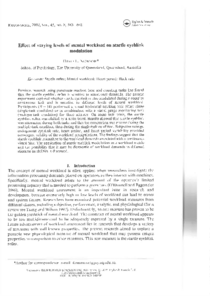Effect of varying levels of mental workload on startle eyeblink modulation

2002
45
8
583-602
eye examination ; heart rate monitoring ; mental workload ; visual tasks ; workload assessment
Risk assessment and risk management
English
Bibliogr.
Previous research using punctuate reaction time and counting tasks has found that the startle eyeblink reflex is sensitive to attentional demands. The present experiment explored whether startle eyeblink is also modulated during a complex continuous task and is sensitive to different levels of mental workload. Participants (N = 14) performed a visual horizontal tracking task either alone (single-task condition) or in combination with a visual gauge monitoring task (multiple-task condition) for three minutes. On some task trials, the startle eyeblink reflex was elicited by a noise burst. Results showed that startle eyeblink was attenuated during both tasks and that the attenuation was greater during the multiple-task condition than during the single-task condition. Subjective ratings, endogenous eyeblink rate, heart period, and heart period variability provided convergent validity of the workload manipulations. The findings suggest that the startle eyeblink is sensitive to the workload demands associated with a continuous visual task. The application of startle eyeblink modulation as a workload metric and the possibility that it may be diagnostic of workload demands in different stimulus modalities is discussed.
Digital
The ETUI is co-funded by the European Union. Views and opinions expressed are however those of the author(s) only and do not necessarily reflect those of the European Union or the ETUI.